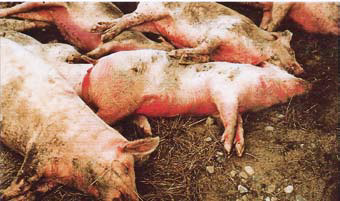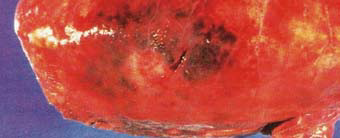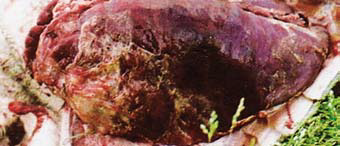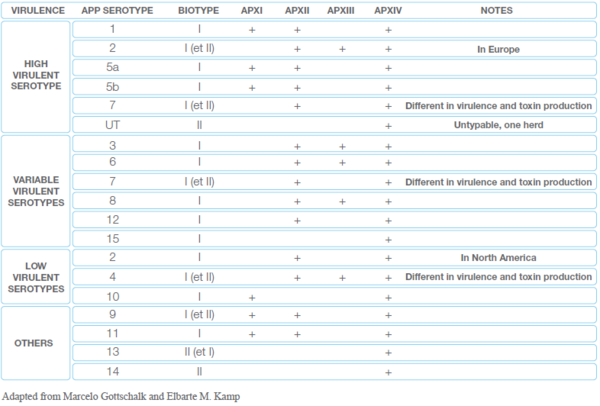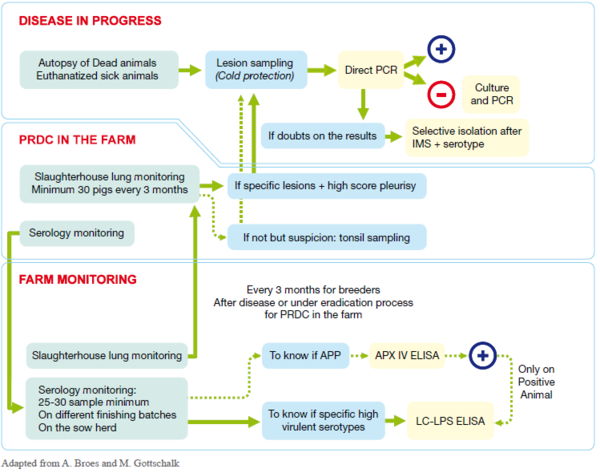.
--> Introduction
--> Disease
--> Conclusion
.
PORCINE PLEUROPNEUMONIA FROM A GOOD DETECTION TO A GOOD PROTECTION
By Dr Eric Brunier, Regional Market Manager – Swine, Ceva Animal Health Asia Pacific
.
INTRODUCTION
Swine pleuropneumonia, due to Actinobacillus pleuropneumoniae, is a major threat for the swine industry. The economical losses have been measured to reach up to 28.000 € in a 600 sow farrow-to-finish farm per year. The losses are due to the mortality, the impact on the performances and the expenses of treatment. Most of the farms don’t pay enough attention to the consequences of strains of low or variable virulence. Surveys done in slaughterhouses show that, depending on the countries, up to 20% of the farms may be contaminated. The diagnosis is an important step for a good protection. It is not easy and needs to follow a stringent procedure to avoid any wrong interpretation.
The protection is too often realised with large amounts of antibiotics with results that are regularly deceiving. No protection can be implemented without a careful screening of any animal entering the farm. At any case, a long term protection must implement different methods including the vaccination.
The porcine pleuropneumoniae caused by Actinobacillus pleuropneumoniae (APP) is considered as a well known disease of economical importance in swine production. Thus, it is a certain risk to underestimate its importance in a period when all the concerns are focusing on PRRS (Porcine Reproductive and Respiratory Syndrome) and PCVAD (Porcine Circovirus type 2 Associated Disease) diseases. Without close monitoring, APP may get unnoticed, among a larger PRDC (Porcine Respiratory Disease Complex) context in the farm. The negative impact on the performances and the economical results, however, are well and truly present. The question, which diagnostic steps to follow to establish and support preventive methods, APPears sometimes unclear and hardly feasible. The aim of this article is to review these factors.
.
DISEASE
APP, under its acute aspect is today well known and easily recognised. It is a respiratory disease with fever, redness of the skin (nose, ears, legs and the whole body), dyspnea, coughing, depression, labored and abdominal breathing, sometimes vomiting. Without treatment, the final outcome is often the death that can occur only within a few hours (up to 50% under experimental conditions) (Picture 1). Despite APPlying an adequate treatment the mortality can remain high. In peracute forms, death may APPear without any previous clinical phase.
Picture 1: High mortality in acute APP
(From Pr G.P Martineau Veterinary School of Toulouse - France)
After autopsy, the characteristic lesions can be well recognised: pneumonia lesions in different lung lobes (part of the diaphragmatic lobe is mostly involved), fibrinous pleurisy and firm abscess-like nodules (Picture 2, Picture 3). When the animals do not die, these lesions often recover. Under experimental conditions, the fibrinous adherences can heal within three months. The losses are significant for the farm. To the lost pig value, we must add the costs of treatment and the performance reduction. Those costs are high because the disease APPears in heavy pigs. The piglets are protected by the maternally derived antibodies (MDA) provided the piglets have a good and early take of colostrum. If the disease may happen as early as six weeks of age, it is more common during the growing and finishing periods. Usually, the farmers use antibiotic treatments at the period MDA drops down; this differs the disease outbreak later; at about 50 to 60 kg of weight up to the end of the finishing period.
Picture 2: Abscess-like nodule
(From LDA 22 – Plougragan - France)
Picture 3: Abscess-like nodule
(From LDA 22 – Plougragan - France)
.
VIRULENCE AND VARIABILITY
The clinical signs and the lesions depend on the virulence of the involved strain. Classically the virulence of A. pleuropneumoniae depends on the antigenic type and can vary with the geographical area. APP is divided in two biotypes, according to the dependence on NAD (Nicotinamide Adenine Dinucleotide) to grow. The strains can be classified to at least 15 serotypes today (13 in biotype I whereas 2 in biotype II). There are also some non-typable strains. In a simple APProach, by the North American experience, we can classify the serotypes after their virulence (Table 1). Beside highly virulent serotypes (1, 5 and 7), we know strains of low virulence as well like serotypes 4 and 10. These strains are usually responsible for the sub-clinical infections i.e. without any visible disease or lesion. Nevertheless, in association with certain cofactors (health, management issues…) they can trigger a clinical disease as well. Other strains have a variable virulence: they are present in a high percentage in conventional herds, usually without any clinical issue. If high virulent strains have clear consequences for a farm, the presence of low or variably virulent strains is much more unclear and cannot be neglected.
Table 1 The serotypes of Actinobacillus pleuropneumoniae
Whatever their virulence, APP is classically present in healthy carriers as well (hidden in the tonsils or the upper part of the respiratory tract). These carriers always represent a risk of the disease outbreak and a threat in the eradication programs since these animals may be not recognized with serological assays.
A disease with many exceptions out of the lines:
Despite having been known since 1957, practitioners and researchers are facing new cases that change the frame we have been aware of until now. The virulence is mostly linked to the nature and the secreted quantity of the exotoxins. Apx I is strongly hemolytic and cytotoxic, Apx II is weakly hemolytic and moderately cytotoxic whereas Apx III is not hemolytic but strongly cytotoxic. So far we don’t know about any toxic effect of Apx IV. Anyway it is essential for APP to express its full virulence. For instance, the serotype 2 is considered as a strain of low virulence in North America (Apx II) and of high virulence in Europe (Apx II and III). But recently, in North America, clinical cases have been attributed to serotype 2 as well. Field cases have shown the possibility, in certain farms, to have a serotype circulating among the sows, whereas another one is circulating among the finishers.
If APP is know as a primary infection, it APPears to be a secondary infection in PRDC context too. APP’s pathogenicity is increased with Mycoplasma hyopneumoniae: a low virulent strain, which can not cause pleuropneumonia alone (e.g. in a breeding farm, negative from any virulent strain of APP), can trigger the disease (in a production farm buying gilts from the breeding farm) in co-infection with M. hyopneumoniae.
.
APP MANAGEMENT IN A FARM
This management needs to be done following a strict process including diagnosis, prevention, treatment and regular monitoring together with good farm practices and biosecurity measures.
1. Diagnosis
The first step to settle is to have a clear idea of the APP situation in the farm. In case of an acute disease, the clinical signs together with the observed postmortem lesions indicate a high level of suspicion to APP. The bacterium isolation will confirm the diagnosis. In case of a chronic PRDC, where APP can be involved as a co-factor together with other agents as M. hyopneumoniae, Haemophilus parasuis, Pasteurella spp., PRRSv, PCV2, Aujeszky disease virus, the clinical signs and lesions are not always obvious. A regular lesion monitoring at the slaughterhouse and bacterium isolation are also required to have the full epidemiological picture.
Figure 1: The APP diagnosis procedure
.
2. Detection of The Bacterium (Direct Diagnosis)
It can be performed from the lung lesions or the palatine tonsils (swabbing, brushing, biopsy or total sampling). The tonsil sampling is done from hogs or culled sows at the slaughterhouse or from live animals in the farm. Either bacterium isolation or PCR (Polymerase Chain Reaction) can be used.
The isolation needs experience and skilled personnel. Most of the laboratories of today have the know-how for this. However, the isolation by culture is very specific but not sensitive enough. Despite this lack of sensitivity, the isolation by culture still remains as golden standard. The sensitivity can be strongly improved by selective bacterial isolation after IMS (Immuno-magnetic separation on micro beads). The isolation is cumbersome and costly. The different PCR assays tend more and more to be used as a first step today. For this, species specific systems must be used. There are also serotype specific assays available. In contrast to the culture, this test is very sensitive; unfortunately the specificity depends on the test used. A study done by the Veterinary Faculty of the University of Montreal – Canada – on 9 published tests and one commercial kit has shown that only two tests had a good sensitivity and high specificity at the same time.
.
3. Indirect Diagnosis
The serological assays are important tools to regularly monitor the status of the farm. Two kinds ELISA tests have recently been developed and may be used complementarily. The LC-LPS ELISA test, developed by the University of Montreal, is commercially distributed by the Company Biovet. This test is serotype specific, highly sensitive and specific and has been validated with a large number of field sera. It is more and more being used as a reference test. If we would like to screen for all serotypes, 7 tests must be performed, which is quite expensive.
The second test is the Apx IV ELISA, commercially distributed by the Company IDEXX. This test is only partially validated on the field; it claims a high specificity and sensitivity. It is species specific. Moreover, it can be used to discriminate the vaccinated animal from the infected ones. To summarise, the following protocols can be advised to screen the APP infection in a farm (see Figure 1). This protocol, however, should be customised for each farm by the Veterinary consultant.
.
4. Antibiotherapy and Metaphylaxy
Once the diagnosis is established, or at least APP is suspected, antibiotic treatment is commenced by injection. When the disease is under development, the antibiotherapy is efficient only if it is set on in a very early stage of the disease. That means the farmer must identify (mark) the sick animals and treat all the animals of the same group.
The antibiotic resistance is distressingly increasing among some serotypes. Among the effective antibiotics are betalactamins, in particular amoxicillin, tetracyclines among witch chlortetracycline and doxycycline, macrolids and affiliated as tiamulin.
Antibio-metaphylaxy: because of carriers and maternal transmission, APP is recurrent in a contaminated farm. The antibio-metaphylaxy is largely used by the farmers with some disparities from one country to another. It may help to control PRDC in the farm, but it can not be a long term solution. The development of antibiotic resistance and the risk of residue issue, becoming more and more sensitive among the consumers worldwide, will limit this solution. An effective vaccination and biosecurity measure should be implemented.
.
5. Vaccination
The following article will unfold this part. In some countries, farmers hesitate to vaccinate because of two difficulties: several commercial vaccines inducing strong post-vaccination reactions can frighten the farmer and lead to some percent of mortality too. The second difficulty for the veterinary consultant is the choice of the right vaccine versus the large range of serotypes. The use of bacterin vaccines has contributed to raise some doubts about the efficiency of the vaccination. Progress in the vaccination engineering has been done since and both issues are solved with COGLAPIX® from Ceva Animal Health.
.
6. Biosecurity
Good technical management and biosecurity measures are essential to solve a PRDC issue. Concerning APP, the essential way of contamination is due to the introduced animals. Fomites and aerosol are of negligible importance.
The gilts and the boars must come from a breeding farm negative for the virulent strains of APP present in the country (of origin). The fact the farm of origin does not have clinical signs does not mean that there is no contamination. At the same time, the quarantine measures must be respected.
In a contaminated farm, the same measures must be taken. The farm must prevent the introduction of other serotypes than the one that is already present in there. The-all-in-all-out management, together with the batch management, a complete disinfection procedure, a strict respect of the density, good ventilation and temperature management are warmly advised at any case.
.
CONCLUSION
In conclusion, APP is an important threat for a farm. Its economical consequences are high. The disease APPears clearly or is hidden inside a PRDC context. There are many serotypes, of which virulence and biological characteristics can vary from one place to another. This variability prevents one from considering the hazard as none with low or variable strains. The protection against this infection requires a strict monitoring and diagnosis protocol.
A strict control of the introduced animals is essential for the farm protection. Once the situation is well understood, an antibio-metaphylaxy can be implemented for a short period; but the long term acceptable solution will go through a good vaccination program with a safe and efficient vaccine, COGLAPIX®.
.
(Source: "Axis Special Swine Issue - Asia Pacific” - November 2009)
.
<< Back to Porcine Pleuropneumonia
<< Back to Disease Informations
Related topics: pleuro-pneumonia detection good protection app

 Corporate Website
Corporate Website
 Africa
Africa
 Argentina
Argentina
 Asia
Asia
 Australia
Australia
 Belgium
Belgium
 Brazil
Brazil
 Bulgaria
Bulgaria
 Canada (EN)
Canada (EN)
 Chile
Chile
 China
China
 Colombia
Colombia
 Denmark
Denmark
 Egypt
Egypt
 France
France
 Germany
Germany
 Greece
Greece
 Hungary
Hungary
 Indonesia
Indonesia
 Italia
Italia
 India
India
 Japan
Japan
 Korea
Korea
 Malaysia
Malaysia
 Mexico
Mexico
 Middle East
Middle East
 Netherlands
Netherlands
 Peru
Peru
 Philippines
Philippines
 Poland
Poland
 Portugal
Portugal
 Romania
Romania
 Russia
Russia
 South Africa
South Africa
 Spain
Spain
 Sweden
Sweden
 Thailand
Thailand
 Tunisia
Tunisia
 Turkey
Turkey
 Ukraine
Ukraine
 United Kingdom
United Kingdom
 USA
USA
 Vietnam
Vietnam

